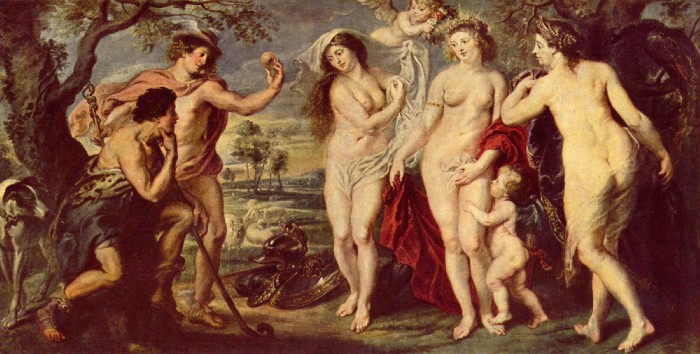
The world’s first beauty contest has held on Mount Ida
The world’s first beauty contest was held at the foot of Mount Ida between Aphrohite, Hera and Athena under the refereeing of Paris.
The names Idaios and Idaia are mentioned in the myths. Idaia means coming from Ida or living in Ida. Mount Ida is known as the Mountain of mythology and legends in the world.
Zeus gives a banquet in honor of the marriage ceremony of Thetis and Peleus, the mother and father of Achilles. But Eris is not invited to this feast. Eris is the goddess of discord and mischief. Arriving at the ceremony in a rage, Eris shouts “for the most beautiful one” and throws a golden apple.
Since each goddess considered herself the most beautiful, they all wanted to own the apple.
Hera, Athena and Aphrohite claim the apple. They then ask Zeus to choose who is the most beautiful among them. Zeus, reluctant to make this choice, announces that Paris, a mortal from Troy, will do the judging. Paris had previously been known for his justice as he had rewarded the god Ares, who was disguised as a bull, for defeating his own bull.

Under the guidance of Hermes, the 3 goddesses went to Mount Ida for Paris to make his choice. There, after bathing in the mountain spring, they showed Paris their power.
Hera offered Paris to make him king of Europe and Asia.
Athena promised him wisdom and skills he could use in battle. Finally, Aphrohite, accompanied by the Kharites and Horas, offered him the love of the most beautiful woman in the world. This woman was Helen of Sparta, wife of the Greek king Menelaus. Paris was so mesmerized by Aphrohite’s grace and beauty that he gave her the golden apple. As the offended goddesses left in a rage, they vowed to take revenge on Paris’ father Priamos and all the people of Troy.
He took Helen at the cost of earning the enmity of the Greeks. The war waged by the Greeks to take Helen back from Paris is known as the famous Trojan War.
Source: Duymaz, A. (2001). Kazdağı ve Sarıkız Efsaneleri Üzerine Bir Değerlendirme. Balıkesir Üniversitesi Sosyal Bilimler Dergisi, Cilt: 4, 96: 96-97
You may also like
- A 1700-year-old statue of Pan unearthed during the excavations at Polyeuktos in İstanbul
- The granary was found in the ancient city of Sebaste, founded by the first Roman emperor Augustus
- Donalar Kale Kapı Rock Tomb or Donalar Rock Tomb
- Theater emerges as works continue in ancient city of Perinthos
- Urartian King Argishti’s bronze shield revealed the name of an unknown country
- The religious center of Lycia, the ancient city of Letoon
- Who were the Luwians?
- A new study brings a fresh perspective on the Anatolian origin of the Indo-European languages
- Perhaps the oldest thermal treatment center in the world, which has been in continuous use for 2000 years -Basilica Therma Roman Bath or King’s Daughter-
- The largest synagogue of the ancient world, located in the ancient city of Sardis, is being restored











Leave a Reply